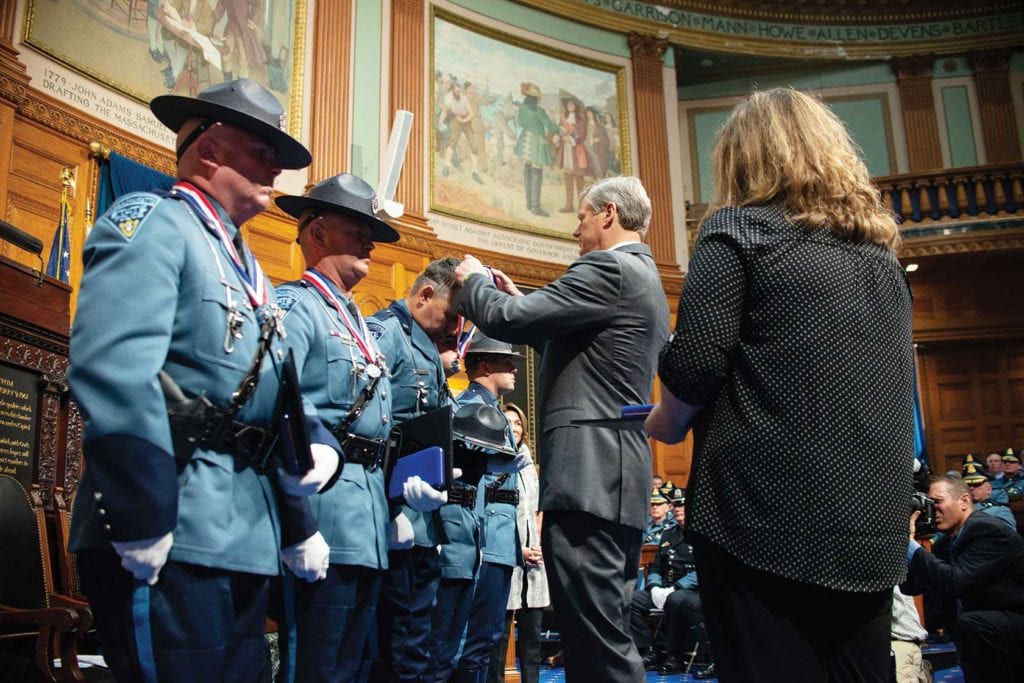A long history of corruption in Massachusetts state police
Report from 1990s warned of lax oversight. Recent revelations show little has changed.

“The hallmark values of the operating culture are self-interest, resentment, and suspicion.”
“We have no defined mission; everything [goes] into a black hole.”
“The only standards around here are double standards.”
Bay State news watchers might guess the quotations above describe the scandal-plagued Mass State Police. They would be correct, but the critiques predate all of the current trooper trouble on the five o’clock news. Instead, the damning remarks come from officers themselves and were included in an eye-popping outside assessment done more than two decades ago that barely saw the light of day after some negative news blips.
With the future of the nation’s oldest motorized statewide police force unclear, and new ethical and legal lapses surfacing regularly, it seems important to attempt to understand how a department that has historically been considered one of the most elite law enforcement operations anywhere arrived at this juncture. For the effort, our research and hindsight has been illuminated by the aforementioned document, a 50-page “Cultural Diagnostic of the Massachusetts State Police” that, as far as we can tell, was buried and largely ignored (some researchers and representatives may have seen it, though, as we found a copy in the Mass State Library after learning about its existence).
Between 2018 and 2019, along with our partners at the Boston Institute for Nonprofit Journalism, MuckRock, and Emerson College, the Boston Institute of Nonprofit Journalism (BINJ) exposed a litany of improprieties with MSP management. Our team showed how the department exceeds budgetary limits by millions of dollars buying weapons, has zero oversight of purchases, and in some cases procures goods from businesses that recently ran afoul of the law and were investigated and fined by Mass Attorney General Maura Healey. In February, we also identified questionable state police contracts with the Arizona-based Taser International for electronic control weapons and consumables, specifically calling attention to how “Taser paid [a lobbying] firm, Lynch Associates, more than $100,000 for ‘relationship development in the Public Safety sector.’” And how Lynch “also happened to be lobbying for Taser’s biggest Massachusetts client, the state police.”
Those and several other revelations turned up in the federal case brought against former State Police Association of Massachusetts President Dana Pullman and Lynch Associates namesake Anne Lynch in August. Both were arrested at their homes, with shocking subsequent headlines about caviar and campaign contributions, but the allegations of conspiracy to commit wire fraud and obstruction of justice in the Pullman case are just the latest potholes in a marathon of bad behavior. From several dozen troopers facing criminal charges in an expansive payroll fiasco, to drunk-driving drill instructors and other one-offs, the follies continue.
Despite bombshell after bombshell broken by reporters at various outlets, it’s difficult to see an end to MSP incompetence and corruption. As Boston Globe reporter Matt Rocheleau observed last week, “Even as new cases of misconduct emerge, including the indictment on Sept. 18 of a trooper who allegedly fired a rifle at an unarmed ATV rider on a Boston highway, the response on Beacon Hill has been roughly the same: crickets. … While lawmakers have wielded their bully pulpits to publicly bash other officials and closely scrutinize other agencies mired in controversy, the state’s largest law enforcement agency has remained virtually unchallenged.”
‘Institutional folklore’
The third-party evaluation that BINJ was recently made aware of and obtained was completed four years after the 1992 consolidation of the Division of State Police, the Metropolitan District Commission Police Force, the Registry of Motor Vehicle’s Law Enforcement Division, and the Capitol Police Department into the singular Department of State Police we have today (commonly referred to as Massachusetts State Police, or MSP). Designed and implemented by the New York-based organizational consultancy Linder & Associates, the diagnostic was commissioned by the Executive Office of Public Safety to ascertain the state of affairs in the wake of such a dramatic reorganization. The firm’s general finding: “The consolidated Department of State Police lacks a coherent, clear mission which can be articulated and measured. This condition has bred … a host of problems.”
While it was researched, written, and buried more than 20 years ago, the Linder document may be as clear and relevant a window to date into the notoriously opaque MSP, which once received a Golden Padlock award for being the most secretive government agency in the United States, and was recently called “one of the most restrictive [departments in Mass] when it comes to access” by MuckRock. Almost every criticism in the 1996 report could apply to the turbulence at all levels of the state police today, from the union brass down to the street soldiers. Furthermore, to the extent the study was at least in part meant to serve as a warning and teaching mechanism for tomorrow’s troopers so they didn’t repeat the same tragic mistakes, the recommendations were demonstrably ignored.
The Metropolitan District Commission Police Force, or MDC, had not been a flawlessly ethical organization before getting absorbed by the state police. There was a major testing scandal in the ’80s that made national news, and enough day-to-day shenanigans to keep newspaper columnists busy. Per the Linder report, “An audit conducted at the request of the Division of Investigations and Intelligence by the Metropolitan District Commission in 1993 found that ‘there is a philosophy of letting things slide until they are forgotten.’”
Any number of factors fueled an inevitable clash of cultures between MDC cops and the staties. Troopers were more buttoned up and military-minded, while most of the former, as one retired metro officer explained for this article, “were street guys who actually walked a beat.” The Linder review notes, “Lapses in training … have reinforced … a fundamental difference between RTs (‘real troopers,’ in the words of those who graduated as recruits from the State Police Academy) and those who are not.”
All of the above considered, the merger was a mess. Per the 1996 report: “The particular cultural strengths of the absorbed Metropolitan, Capitol, and Registry entities have not been recognized and leveraged into a whole that is greater than the sum of its parts.”
In order to determine just how bad things were, Linder & Associates mailed “an eleven-page survey instrument” “to every uniformed member” of the department, plus sent separate one-page surveys to police chiefs and district attorneys across the state. In response it received 859 questionnaires out of 2,255 mailed, making for a 38.1% response rate that was “higher than expected; since this was a mailback survey which required at least 25 minutes of unpaid time to fill out.”
The consultants didn’t get much help from state police. “None of the materials provided by MSP indicate how many cruisers are at what locations and assigned to whom,” the researchers wrote. “No member of the Command Staff or Fleet administration appeared to possess this information.” Administrators wouldn’t even release “current and historical information on the rates of summonses for moving violations, arrests, investigative cases closed by arrest, etc.” The anonymous respondents, however, were open and explicit, identifying tragic shortcomings in every operational category:
Mission: “The vast majority of troopers and supervisors interviewed express disenchantment with a sense that the mission of their organization is not clear.” “No one has any idea what the leadership wants or what their priority is.”
Management: “A lack of standards applies to all facets of the job.” “Fairness and professionalism are organizational values receding into memory and institutional folklore.”
Equipment: “Radio systems were not and are not compatible.” “A number of those interviewed … agreed with the sentiment that ‘the installation of E-mail, even for Command Staff alone, would eliminate enormous amounts of paperwork, but no one wants anything [like] a traceable record of any kind.’”
Personnel: “The General Counsel indicated that only three MSP personnel have been fired since Consolidation, and those only because they were convicted felons. In one of these instances, the individual in question was promoted to sergeant with an indictment pending.” “The widespread impression exists in the Department that no action was taken against a trooper found to be harassing a female member, another stalking a former girlfriend, and others driving under the influence of alcohol.”
Then and now
There are a lot of recommendations and warnings in the Linder report. Judging by developments in the time since, few if any appear to have been followed or heeded.
Back then, researchers found that some respondents “maintain[ed] that [recruit training] is unnecessarily harsh, designed in part to drive out female candidates.” Yet throughout the early 2000s, the department was embroiled in a lawsuit over its unfair treatment of pregnant troopers and has continued in that tradition in the time since, according to public reports as well as inside sources.
In 1996, the Linder diagnostic found, “The Department of State Police will be hindered in the effort to become a high-performance organization by a lack of adequate budgetary, procurement, and financial controls.” This was a no-brainer, since in years prior the state auditor had found “improper authorization, delivery, and acceptance … of an estimated $990,000 worth of computer products … [and an] authorized payment of $454,535 to a third party vendor … who received payment for … computer equipment that it had not provided.” Despite that history, in 2019 MSP continues to procure without oversight, and as a result has been a hotbed of bribes and pay-to-play kickback schemes.
On the payroll front, back then, “a number of those interviewed [by Linder said] some troopers take ‘beeper days,’ for which they receive full duty pay while they are actually responding only to those calls directed to their beepers.” As anybody who has paid attention to the current payroll scandal can attest, that part of the culture hasn’t changed.
In the ’90s, Linder wrote, “the MSP Crime Lab is seriously understaffed, and unable to keep up with current case loads.” One lab staffer, speaking about the backlog of more than 5,000 unprocessed drug samples at the time, said, “If we never had a new piece of evidence brought in here, it would still take us at least two years to catch up to what we have backed up now.” Fast-forward to 2012, when the state police crime lab was shut down following reports of improper evidence handling.
All told, so much hostility against reform may seem harrowing, but it’s one that many respondents predicted. Quoting an especially cynical response to their survey, researchers wrote: “The perception of many members may be summarized by the remark of one made in the course of this study: ‘Nothing you can recommend or say in this report you’re doing will result in positive reform of any kind—the absolute only thing that will happen is management will comb through it trying to figure out who said what so they can mete out their usual vindictive, vicious, and arbitrary punishments; there is no interest whatsoever in progress or competence, and wherever the management can lash out and make people pay for telling the truth, believe me they will—as they have in the past, many times, without hesitation and without logic.’”
This article was also published in DigBoston.






